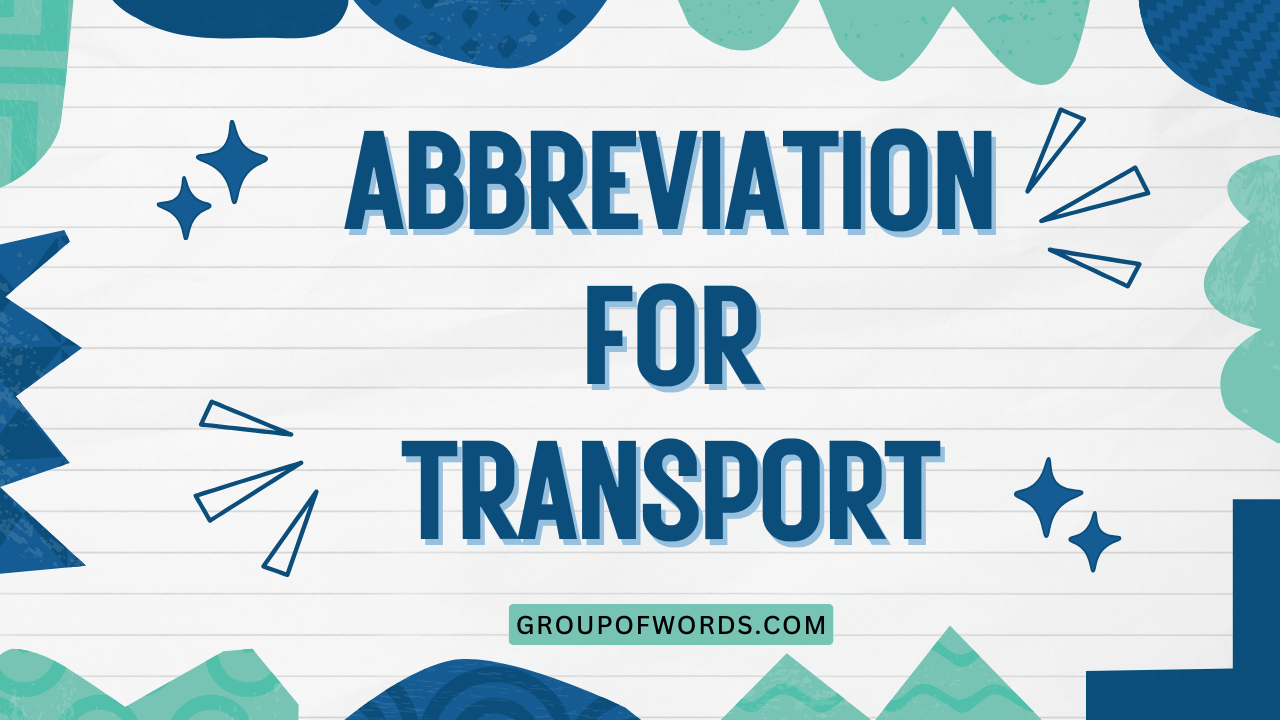Abbreviations for Transport: A Comprehensive Guide
Understanding abbreviations for transport is crucial for effective communication in various contexts, from casual conversations to formal reports. These abbreviations are ubiquitous in everyday life, appearing on road signs, timetables, and travel documents.
Mastering them not only enhances comprehension but also improves writing clarity and efficiency. This guide provides a detailed exploration of transport abbreviations, their structures, usage rules, and common pitfalls, benefiting students, professionals, and anyone seeking to improve their English language skills.
Table of Contents
- Introduction
- Definition of Transport Abbreviations
- Structural Breakdown
- Types of Transport Abbreviations
- Examples of Transport Abbreviations
- Usage Rules for Transport Abbreviations
- Common Mistakes with Transport Abbreviations
- Practice Exercises
- Advanced Topics
- Frequently Asked Questions (FAQ)
- Conclusion
Introduction
In the realm of language, abbreviations serve as shorthand representations of longer words or phrases. When it comes to transport, abbreviations are exceptionally common, streamlining communication across various travel-related contexts.
From deciphering road signs to understanding flight schedules, a solid grasp of these abbreviations is invaluable. This comprehensive guide aims to equip you with the knowledge and skills necessary to confidently navigate the world of transport abbreviations, enhancing both your comprehension and communication abilities.
This article is designed for English language learners of all levels, as well as professionals in fields such as logistics, tourism, and transportation. By understanding the structure, types, and usage rules of these abbreviations, you will be able to interpret information more efficiently and communicate more effectively in both written and spoken English.
Whether you’re a student preparing for an exam or a seasoned traveler planning your next adventure, this guide will provide you with the tools you need to succeed.
Definition of Transport Abbreviations
A transport abbreviation is a shortened form of a word or phrase related to modes of transportation, infrastructure, or related services. These abbreviations are used to save space, time, and improve readability in various documents, signs, and conversations.
They can represent specific types of vehicles, routes, facilities, or administrative terms commonly associated with transport systems. The use of transport abbreviations is ubiquitous in modern society, making their understanding essential for effective communication.
Transport abbreviations can be classified based on the mode of transport they represent, such as road, rail, air, and water. They can also be categorized by their function, such as indicating a type of vehicle (e.g., bus, train, aircraft), a location (e.g., airport, station, port), or a regulatory body (e.g., DOT, FAA, IMO).
The context in which an abbreviation is used often provides clues to its meaning, although some abbreviations have multiple meanings depending on the specific field.
Structural Breakdown
Transport abbreviations are typically formed using one of several common methods:
- Initialism: Using the first letter of each word in a phrase (e.g., DOT for Department of Transportation).
- Acronym: Forming a new word from the first letters of a phrase (e.g., Amtrak, blending “American” and “track”).
- Contraction: Shortening a word by removing letters from the middle (e.g., Rd for Road).
- Clipping: Shortening a word by removing letters from the beginning or end (e.g., Bus from Omnibus).
- Combination: Combining elements of the above methods (e.g., Intl for International).
Understanding these structural patterns can help in deciphering unfamiliar abbreviations. Initialisms are often written in all capital letters, while acronyms may be capitalized or written in lowercase depending on common usage.
Contractions and clippings are usually written with a mix of uppercase and lowercase letters, and they may or may not include a period at the end.
The formation of abbreviations often follows conventions specific to certain industries or regions. For example, abbreviations used in aviation may differ from those used in maritime transport.
Additionally, some abbreviations are more widely recognized and accepted than others. Therefore, it’s important to consider the audience and context when choosing which abbreviations to use.
Types of Transport Abbreviations
Transport abbreviations can be broadly categorized based on the mode of transport they relate to. Here are the main categories:
Road Transport
Road transport abbreviations include those related to cars, buses, trucks, roads, and highways. These abbreviations are commonly found on road signs, maps, and in traffic reports.
Understanding them is essential for safe and efficient navigation on roads.
Rail Transport
Rail transport abbreviations pertain to trains, railways, stations, and related infrastructure. They are frequently used in train schedules, station signage, and railway engineering documents.
Familiarity with these abbreviations can help travelers navigate train systems more easily.
Air Transport
Air transport abbreviations encompass airplanes, airports, airlines, and air traffic control. These abbreviations are prevalent in flight schedules, airport signage, and aviation regulations.
A strong understanding of these terms is vital for pilots, air traffic controllers, and airline passengers.
Water Transport
Water transport abbreviations refer to ships, boats, ports, and maritime routes. They are used in shipping manifests, port regulations, and nautical charts.
Knowledge of these abbreviations is essential for sailors, shipping professionals, and marine engineers.
General Transport
General transport abbreviations are those that apply to multiple modes of transport or to transport in general. These can include terms related to logistics, infrastructure, and regulations that are not specific to any one mode of transport.
They are often used in policy documents, research reports, and general discussions about transportation.
Examples of Transport Abbreviations
To further illustrate the use of transport abbreviations, here are several examples organized by category. These examples cover a wide range of common abbreviations used in various transport contexts.
Road Transport Examples
The following table provides examples of common road transport abbreviations, along with their full forms and typical usage contexts. This will help you understand how these abbreviations are used in real-world scenarios.
| Abbreviation | Full Form | Usage Context |
|---|---|---|
| Rd | Road | Street address, road signs |
| St | Street | Street address, road signs |
| Ave | Avenue | Street address, road signs |
| Blvd | Boulevard | Street address, road signs |
| Hwy | Highway | Road signs, maps |
| Fwy | Freeway | Road signs, maps |
| Tpke | Turnpike | Road signs, toll roads |
| Cir | Circle | Street address, road signs |
| Ln | Lane | Street address, road signs |
| Dr | Drive | Street address, road signs |
| Cres | Crescent | Street address, road signs |
| Pl | Place | Street address, road signs |
| Ct | Court | Street address, road signs |
| DOT | Department of Transportation | Government regulations, policy documents |
| DMV | Department of Motor Vehicles | Licensing, vehicle registration |
| Pkwy | Parkway | Road signs, maps |
| Rte | Route | Road signs, maps |
| N | North | Directional signage |
| S | South | Directional signage |
| E | East | Directional signage |
| W | West | Directional signage |
| NB | Northbound | Traffic reports, road signs |
| SB | Southbound | Traffic reports, road signs |
| EB | Eastbound | Traffic reports, road signs |
| WB | Westbound | Traffic reports, road signs |
| P&R | Park and Ride | Public transportation, commuter services |
| HOV | High Occupancy Vehicle | Road signs, traffic regulations |
| LTL | Less Than Truckload | Freight shipping, logistics |
Rail Transport Examples
This table provides examples of common rail transport abbreviations, along with their full forms and typical usage contexts. Understanding these abbreviations is essential for navigating train schedules and railway systems.
| Abbreviation | Full Form | Usage Context |
|---|---|---|
| RR | Railroad | Company names, historical documents |
| Stn | Station | Train schedules, station signage |
| Jct | Junction | Railway maps, signaling |
| Crossing | Railway safety, signage | |
| Amtrak | American Track | Passenger rail service |
| RTD | Regional Transportation District | Public transit, commuter rail |
| LRT | Light Rail Transit | Urban rail systems |
| HSR | High-Speed Rail | Modern railway technology |
| EMU | Electric Multiple Unit | Electric trains |
| DMU | Diesel Multiple Unit | Diesel trains |
| RER | Réseau Express Régional | Parisian suburban rail network |
| TGV | Train à Grande Vitesse | French high-speed train |
| ICE | InterCity Express | German high-speed train |
| Ltd | Limited | Limited stop service |
| Exp | Express | Express train service |
| IC | Intercity | Intercity train service |
| RE | Regional Express | Regional Express train service |
| S-Bahn | Stadtschnellbahn | German suburban railway |
| U-Bahn | Untergrundbahn | German underground railway |
| VIA | VIA Rail Canada | Canadian passenger rail service |
| BART | Bay Area Rapid Transit | San Francisco Bay Area rapid transit |
| MNR | Metro-North Railroad | New York suburban railroad |
| NJT | New Jersey Transit | New Jersey public transportation |
| SEPTA | Southeastern Pennsylvania Transportation Authority | Philadelphia public transportation |
| CTA | Chicago Transit Authority | Chicago public transportation |
| MBTA | Massachusetts Bay Transportation Authority | Boston public transportation |
| WMATA | Washington Metropolitan Area Transit Authority | Washington D.C. public transportation |
Air Transport Examples
This table provides examples of common air transport abbreviations, along with their full forms and typical usage contexts. A strong understanding of these abbreviations is vital for anyone involved in aviation or air travel.
| Abbreviation | Full Form | Usage Context |
|---|---|---|
| Intl | International | Airport names, flight schedules |
| Apt | Airport | Airport names, maps |
| FAA | Federal Aviation Administration | Aviation regulations, safety standards |
| IATA | International Air Transport Association | Airline industry standards, airport codes |
| ICAO | International Civil Aviation Organization | International aviation regulations |
| ATC | Air Traffic Control | Airspace management, flight safety |
| ETA | Estimated Time of Arrival | Flight tracking, schedules |
| ETD | Estimated Time of Departure | Flight tracking, schedules |
| PAX | Passengers | Airline operations, capacity planning |
| Cargo | Cargo | Air freight, logistics |
| DEP | Departure | Flight schedules, airport displays |
| ARR | Arrival | Flight schedules, airport displays |
| FLT | Flight | Flight numbers, tracking |
| GND | Ground | Airport operations, ground control |
| TWR | Tower | Airport control tower |
| APP | Approach | Air traffic control procedures |
| SID | Standard Instrument Departure | Flight procedures |
| STAR | Standard Terminal Arrival Route | Flight procedures |
| VOR | VHF Omnidirectional Range | Navigation aid |
| ILS | Instrument Landing System | Landing aid |
| FIR | Flight Information Region | Airspace division |
| AIP | Aeronautical Information Publication | Aviation information |
| NOTAM | Notice to Airmen | Temporary flight hazards |
| TSA | Transportation Security Administration | Airport security |
| Jet | Jet | Jet aircraft |
| UAV | Unmanned Aerial Vehicle | Drones |
Water Transport Examples
This table provides examples of common water transport abbreviations, along with their full forms and typical usage contexts. Knowledge of these abbreviations is essential for anyone involved in maritime transport or nautical activities.
| Abbreviation | Full Form | Usage Context |
|---|---|---|
| IMO | International Maritime Organization | Maritime regulations, safety standards |
| Port | Port | Harbor facilities, shipping |
| Nav | Navigation | Nautical charts, GPS systems |
| S.S. | Steamship | Historical shipping records |
| M.V. | Motor Vessel | Modern shipping vessels |
| GT | Gross Tonnage | Ship size measurement |
| NT | Net Tonnage | Ship cargo capacity |
| TEU | Twenty-foot Equivalent Unit | Container shipping |
| LOA | Length Overall | Ship dimensions |
| MMSI | Maritime Mobile Service Identity | Vessel identification |
| VHF | Very High Frequency | Marine radio communication |
| GPS | Global Positioning System | Satellite navigation |
| AIS | Automatic Identification System | Vessel tracking |
| SOLAS | Safety of Life at Sea | Maritime safety regulations |
| MARPOL | Marine Pollution | Environmental regulations |
| ETA | Estimated Time of Arrival | Shipping schedules |
| ETD | Estimated Time of Departure | Shipping schedules |
| ULCC | Ultra Large Crude Carrier | Oil tanker |
| VLCC | Very Large Crude Carrier | Oil tanker |
| LNG | Liquefied Natural Gas | Gas carrier |
| LPG | Liquefied Petroleum Gas | Gas carrier |
| RoRo | Roll-on/Roll-off | Cargo ship |
| ULCS | Ultra Large Container Ship | Container ship |
| FEU | Forty-foot Equivalent Unit | Container shipping |
| GRT | Gross Registered Tonnage | Ship measurement |
| DWT | Deadweight Tonnage | Ship carrying capacity |
General Transport Examples
This table provides examples of general transport abbreviations, along with their full forms and typical usage contexts. These abbreviations apply to multiple modes of transport and are commonly used in logistics, policy, and research.
| Abbreviation | Full Form | Usage Context |
|---|---|---|
| Trans | Transportation | General references, policy documents |
| Log | Logistics | Supply chain management, freight |
| Pkg | Package | Shipping, delivery services |
| LTL | Less Than Truckload | Freight shipping |
| FTL | Full Truckload | Freight shipping |
| Intermodal | Intermodal Transportation | Combining multiple transport modes |
| ITS | Intelligent Transportation Systems | Technology in transportation |
| R&D | Research and Development | Transportation technology |
| EV | Electric Vehicle | Sustainable transportation |
| CNG | Compressed Natural Gas | Alternative fuel |
| LPG | Liquefied Petroleum Gas | Alternative fuel |
| GHG | Greenhouse Gas | Environmental impact |
| DOT | Department of Transportation | Government regulations |
| EPA | Environmental Protection Agency | Environmental regulations |
| USDOT | United States Department of Transportation | US transportation policy |
| EU | European Union | European transportation policy |
| UN | United Nations | International transport standards |
| GDP | Gross Domestic Product | Economic impact of transport |
| Km | Kilometer | Distance measurement |
| Mi | Mile | Distance measurement |
| HR | Human Resources | Transportation workforce |
| IT | Information Technology | Transportation technology |
| GIS | Geographic Information System | Mapping and spatial analysis |
| IoT | Internet of Things | Connected transport systems |
| AI | Artificial Intelligence | Automated transport |
Usage Rules for Transport Abbreviations
Proper usage of transport abbreviations involves adhering to certain guidelines to ensure clarity and avoid confusion. Here are some key rules to follow:
- Context is Key: Always consider the context in which you are using an abbreviation. Some abbreviations have multiple meanings, so the surrounding text should provide sufficient clues to the intended meaning.
- Consistency: Maintain consistency in your use of abbreviations throughout a document or conversation. If you use an abbreviation once, stick with it rather than switching to the full form or a different abbreviation.
- Audience Awareness: Be mindful of your audience’s familiarity with the abbreviations you are using. If you are writing for a general audience, it’s best to spell out the full form of an abbreviation the first time you use it, followed by the abbreviation in parentheses.
- Formal vs. Informal: In formal writing, it’s generally best to avoid excessive use of abbreviations. However, in informal settings, such as emails or text messages, abbreviations can be used more freely.
- Punctuation: Follow standard punctuation rules for abbreviations. Initialisms are typically written without periods (e.g., DOT), while contractions and clippings may or may not include a period (e.g., Rd or Rd.).
- Capitalization: Capitalize initialisms and acronyms according to common usage. Some acronyms are written in all capital letters (e.g., IATA), while others are written in lowercase (e.g., Amtrak).
Exceptions to these rules may exist in specific industries or regions. For example, certain abbreviations may be universally recognized within a particular field, even if they are not widely known outside of it.
In such cases, it’s acceptable to use these abbreviations without spelling out the full form first.
Common Mistakes with Transport Abbreviations
Several common mistakes can occur when using transport abbreviations. Being aware of these errors can help you avoid them and improve the clarity of your communication.
- Misinterpreting Abbreviations: Mistaking one abbreviation for another due to similar letters or lack of context. For example, confusing ETA (Estimated Time of Arrival) with ETD (Estimated Time of Departure).
- Overusing Abbreviations: Using too many abbreviations in a document, making it difficult for readers to understand. It’s important to strike a balance between brevity and clarity.
- Using Unfamiliar Abbreviations: Using abbreviations that are not widely recognized or accepted, which can confuse or alienate your audience.
- Inconsistent Usage: Switching between the full form and the abbreviation of a term within the same document, which can be distracting and unprofessional.
- Incorrect Punctuation: Misusing periods or capitalization in abbreviations, which can alter their meaning or make them look incorrect.
Here are some examples of correct and incorrect usage:
| Incorrect | Correct | Explanation |
|---|---|---|
| The E.T.A. is 14:00. | The ETA is 14:00. | Initialisms are typically written without periods. |
| The road is blocked due to an acc. | The road is blocked due to an accident. | Avoid using obscure abbreviations that may not be understood. |
| The Dep. will be delayed. | The departure will be delayed. | Maintain consistency in using either the full form or the abbreviation. |
| The train is arriving at Sta. | The train is arriving at Stn. | Use the correct standard abbreviation for the term. |
| He works for the Dept. of Transportation. | He works for the Department of Transportation. | In formal writing, spell out the full form on the first use. |
| We need to ship the package LTL. | We need to ship the package less than truckload. | If the audience may not understand, spell it out. |
Practice Exercises
To test your understanding of transport abbreviations, complete the following exercises. Each exercise consists of multiple-choice questions or fill-in-the-blank statements.
Check your answers against the solutions provided at the end.
Exercise 1: Multiple Choice
| Question | Options | Answer |
|---|---|---|
| What does “Hwy” stand for? | (a) Highway (b) High way (c) High wire (d) High water | (a) |
| What does “RR” stand for? | (a) Road Runner (b) Rail Route (c) Railroad (d) Rapid Rail | (c) |
| What does “FAA” stand for? | (a) Federal Aviation Association (b) Federal Aviation Administration (c) Foreign Airline Association (d) Flight Aviation Authority | (b) |
| What does “IMO” stand for? | (a) International Motor Organization (b) International Maritime Organization (c) Inland Marine Office (d) Island Marine Organization | (b) |
| What does “ETA” stand for? | (a) Early Time of Arrival (b) Estimated Time of Arrival (c) Exit Time Arrival (d) Extra Time Arrival | (b) |
| What does “DOT” stand for? | (a) Department of Traffic (b) Department of Transit (c) Department of Transportation (d) Division of Transport | (c) |
| What does “Stn” stand for? | (a) Street (b) Station (c) Stone (d) Stain | (b) |
| What does “Ave” stand for? | (a) Advance (b) Avenue (c) Average (d) Avocation | (b) |
| What does “Blvd” stand for? | (a) Bold (b) Boulevard (c) Blind (d) Blob | (b) |
| What does “Fwy” stand for? | (a) Fairway (b) Freeway (c) Fireway (d) Funway | (b) |
Exercise 2: Fill in the Blanks
| Question | Answer |
|---|---|
| The ___________ regulates aviation safety standards. | FAA |
| The train is scheduled to arrive at the ___________ at 10:00 AM. | Stn |
| The ___________ is responsible for maritime regulations. | IMO |
| The ___________ is blocked due to construction. | Hwy |
| What is the ___________ for your flight? | ETA |
| The ___________ is in charge of transport policy. | DOT |
| The address is 123 Main _______________. | St |
| Take the _______________ to get to the airport. | Fwy |
| The meeting point is at the _______________. | Jct |
| Please proceed to _______________ for your connecting flight. | Intl |
Exercise 3: Abbreviation Identification
| Question | Answer |
|---|---|
| What is the full form of LTL? | Less Than Truckload |
| What is the full form of CNG? | Compressed Natural Gas |
| What is the full form of GPS? | Global Positioning System |
| What is the full form of IATA? | International Air Transport Association |
| What is the full form of TEU? | Twenty-foot Equivalent Unit |
| What is the full form of EV? | Electric Vehicle |
| What is the full form of M.V.? | Motor Vessel |
| What is the full form of ATC? | Air Traffic Control |
| What is the full form of P&R? | Park and Ride |
| What is the full form of HOV? | High Occupancy Vehicle |
Answers to Exercises:
Exercise 1: 1. (a), 2. (c), 3. (b), 4. (b), 5. (b), 6. (c), 7. (b), 8. (b), 9. (b), 10. (b)
Exercise 2: 1. FAA, 2. Stn, 3. IMO, 4. Hwy, 5. ETA, 6. DOT, 7. St, 8. Fwy, 9. Jct, 10. Intl
Exercise 3: See the tables in the “Examples” section for answers.
Advanced Topics
For advanced learners, several more complex aspects of transport abbreviations are worth exploring. These topics delve into the nuances of abbreviation usage in specialized contexts.
- Regional Variations: Transport abbreviations can vary significantly between different countries and regions. For example, abbreviations used in the United States may differ from those used in Europe or Asia.
- Industry-Specific Jargon: Certain industries, such as aviation and maritime transport, have their own unique sets of abbreviations that are not widely known outside of those fields.
- Historical Abbreviations: Some transport abbreviations are no longer in common use but may still appear in historical documents or older publications. Understanding these abbreviations can be important for historical research.
- Evolving Standards: The standards for transport abbreviations are constantly evolving as new technologies and practices emerge. Staying up-to-date with these changes is essential for professionals in the transport industry.
- Abbreviations in Legal and Regulatory Contexts: Legal and regulatory documents often use specific abbreviations that have precise definitions. Misinterpreting these abbreviations can have serious consequences.
Further research into these advanced topics can provide a deeper understanding of the complexities of transport abbreviations and their role in various fields.
Frequently Asked Questions (FAQ)
Here are some frequently asked questions about transport abbreviations:
- Why are transport abbreviations used?
Transport abbreviations are used to save space, time, and improve readability in various documents, signs, and conversations. They allow for more concise communication and reduce the need to write out lengthy terms repeatedly.
- How can I learn new transport abbreviations?
The best way to learn new transport abbreviations is to
study relevant materials, such as road maps, flight schedules, and shipping documents. You can also consult online resources, such as dictionaries and glossaries of transport terms. Additionally, pay attention to the abbreviations used in your daily life, and ask for clarification when you encounter unfamiliar ones.
- Are transport abbreviations universal?
No, transport abbreviations are not always universal. They can vary between different countries, regions, and industries. Therefore, it’s important to consider the context in which an abbreviation is used and to be aware of potential regional variations.
- Can I make up my own transport abbreviations?
It’s generally not a good idea to make up your own transport abbreviations, as this can cause confusion and miscommunication. Stick to using established and widely recognized abbreviations whenever possible. If you need to refer to a term that does not have a standard abbreviation, spell it out in full.
- How do I know when to spell out an abbreviation?
Spell out an abbreviation the first time you use it in a document or conversation, especially if you are writing for a general audience. After that, you can use the abbreviation freely. However, if you are writing for a specialized audience that is likely to be familiar with the abbreviation, you may not need to spell it out.
- What should I do if I don’t understand a transport abbreviation?
If you don’t understand a transport abbreviation, don’t hesitate to ask for clarification. You can consult online resources, such as dictionaries and glossaries, or ask a knowledgeable colleague or friend. It’s better to ask for clarification than to make assumptions that could lead to misunderstandings.
Conclusion
In conclusion, mastering transport abbreviations is essential for effective communication in a wide range of contexts. By understanding the structure, types, and usage rules of these abbreviations, you can improve your comprehension, writing clarity, and overall communication skills.
Whether you’re a student, a professional, or simply someone who wants to enhance their English language skills, this guide has provided you with the tools you need to succeed. Remember to practice regularly, stay up-to-date with evolving standards, and always consider the context and audience when using transport abbreviations.
With dedication and effort, you can confidently navigate the world of transport abbreviations and communicate effectively in any situation.






